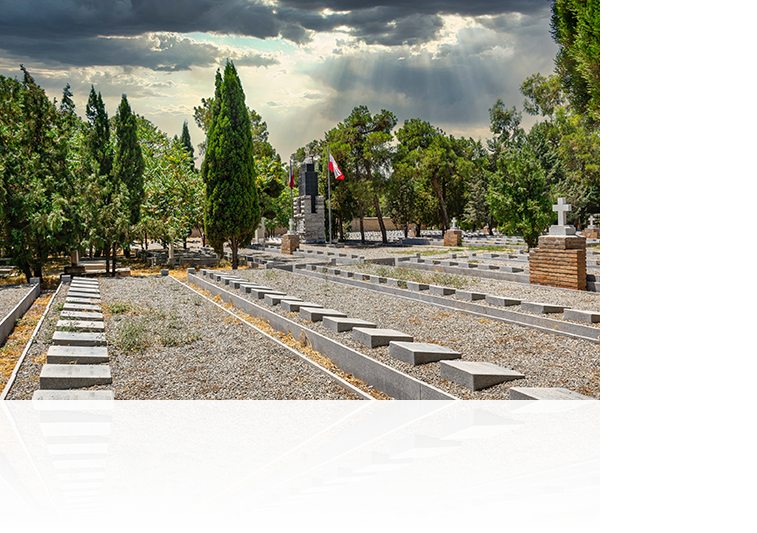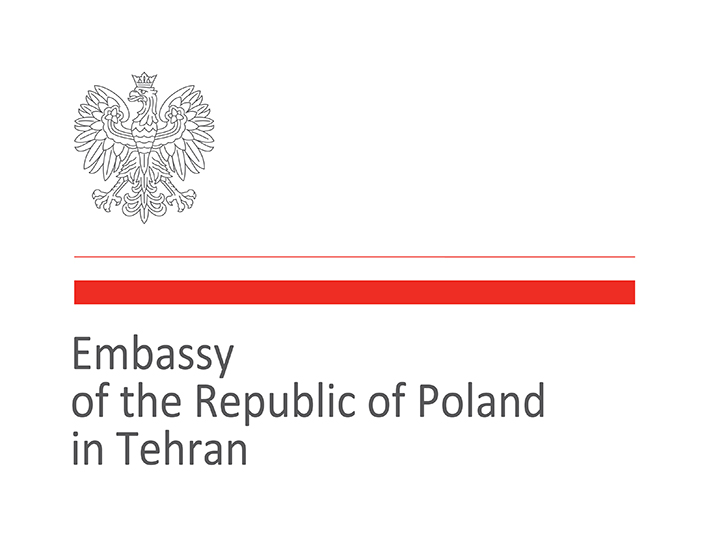Polish Cemetery
In Doulab, Tehran
In 1942, as a result of the evacuation of Polish civilian and military refugees from the territory of the USSR, more than 120,000 Poles arrived in Iran. There were over 77,000 soldiers and 43,000 civilians including about 20,000 children who arrived on the Iranian shore in Bandar Anzali under the command of General Władysław Anders.
The Polish cemetery is located in Eastern Tehran as part the of the Doulab Catholic Cemetery. It constitutes the largest burial site for Polish refugees from World War II on Iranian soil. The Polish section was established in 1942, with 1,937 graves including 409 soldiers and 1,528 civilians.
The stories of those buried in Doulab are part of the tumultuous history of Poland during the Second World War. Before the outbreak of war, most of them lived in Eastern Poland. Following the aggression of Nazi Germany and the Soviet Union against Poland in September 1939, these areas came under Soviet occupation. The Soviet authorities carried out mass deportations of Polish citizens from these areas to labour camps deep inside the Soviet Union.
When Nazi Germany attacked the USSR in June 1941, the Prime Minister of the Polish government-in-exile, General Władysław Sikorski, and the USSR Ambassador to the United Kingdom, Ivan Mayski, signed a treaty to "give each other all kinds of help and support in the war against Nazi Germany". As a result of the signed treaty, the Soviet government announced an 'amnesty' for Polish citizens held in prisons, labour camps and in exile in the USSR, and it was decided to create a Polish Army in the USSR, under the command of General Władysław Anders.
Between 1942 and 1943, refugees were gradually being evacuated from the territory of the USSR to Iran. It was the largest exodus in numbers of former prisoners of camps and exiles outside the USSR during the entire Stalinist period.
Many refugees didn't survive the hardships of the journey and died upon their arrival in Iran or shortly afterwards. We can find today several Polish cemeteries in the country, where a total of 2,806 Polish citizens, including 650 military personnel, who died between 1942 and 1944, are buried. Polish graves can also be found in the Jewish and British cemeteries in Tehran and in the Christian cemeteries in Bandar Anzali, Ahwaz, Mashhad and Isfahan. Polish graves were also located in other cities of Iran, including the now defunct cemeteries in Kazvin and Khorramshahr.
The Polish section of the Doulab cemetery contains also about 50 graves of Poles who died in Tehran in the post-war period. Among them are General Antoni Radziwill de Borowski, who died in 1898, as well as Wladyslaw Horodecki, a prominent architect who died in 1930.
The story of the Polish soldiers and refugees who arrived in Iran in 1942 does not end there. Some civilians, including children, were evacuated from Iran to India, East Africa, New Zealand or Mexico. A few remained in Iran - these were mainly women who had married Iranian citizens. Military units however were gradually moved towards Iraq, Syria and Palestine. The Polish II Corps was formed there in mid-1943 and then redeployed to Italy. It took part in the Battle of Monte Cassino, the liberation of Ancona and Bologna. As in Iran, there are Polish cemeteries in Italy, where 4,000 fallen soldiers are buried.
After the end of the Second World War, many soldiers of the Polish Second Corps were unable to return home. They were born in the eastern areas of pre-war Poland that had been then incorporated into the Soviet Union. Some settled in the United Kingdom, while many emigrated to the USA, Canada, Australia or South America. The Soviet authorities arrested those who tried to return to their pre-war homes and deported them to Siberia together with their families. They were able to return from exile after 1956.
The Polish cemetery is located in Eastern Tehran as part the of the Doulab Catholic Cemetery. It constitutes the largest burial site for Polish refugees from World War II on Iranian soil. The Polish section was established in 1942, with 1,937 graves including 409 soldiers and 1,528 civilians.
The stories of those buried in Doulab are part of the tumultuous history of Poland during the Second World War. Before the outbreak of war, most of them lived in Eastern Poland. Following the aggression of Nazi Germany and the Soviet Union against Poland in September 1939, these areas came under Soviet occupation. The Soviet authorities carried out mass deportations of Polish citizens from these areas to labour camps deep inside the Soviet Union.
When Nazi Germany attacked the USSR in June 1941, the Prime Minister of the Polish government-in-exile, General Władysław Sikorski, and the USSR Ambassador to the United Kingdom, Ivan Mayski, signed a treaty to "give each other all kinds of help and support in the war against Nazi Germany". As a result of the signed treaty, the Soviet government announced an 'amnesty' for Polish citizens held in prisons, labour camps and in exile in the USSR, and it was decided to create a Polish Army in the USSR, under the command of General Władysław Anders.
Between 1942 and 1943, refugees were gradually being evacuated from the territory of the USSR to Iran. It was the largest exodus in numbers of former prisoners of camps and exiles outside the USSR during the entire Stalinist period.
Many refugees didn't survive the hardships of the journey and died upon their arrival in Iran or shortly afterwards. We can find today several Polish cemeteries in the country, where a total of 2,806 Polish citizens, including 650 military personnel, who died between 1942 and 1944, are buried. Polish graves can also be found in the Jewish and British cemeteries in Tehran and in the Christian cemeteries in Bandar Anzali, Ahwaz, Mashhad and Isfahan. Polish graves were also located in other cities of Iran, including the now defunct cemeteries in Kazvin and Khorramshahr.
The Polish section of the Doulab cemetery contains also about 50 graves of Poles who died in Tehran in the post-war period. Among them are General Antoni Radziwill de Borowski, who died in 1898, as well as Wladyslaw Horodecki, a prominent architect who died in 1930.
The story of the Polish soldiers and refugees who arrived in Iran in 1942 does not end there. Some civilians, including children, were evacuated from Iran to India, East Africa, New Zealand or Mexico. A few remained in Iran - these were mainly women who had married Iranian citizens. Military units however were gradually moved towards Iraq, Syria and Palestine. The Polish II Corps was formed there in mid-1943 and then redeployed to Italy. It took part in the Battle of Monte Cassino, the liberation of Ancona and Bologna. As in Iran, there are Polish cemeteries in Italy, where 4,000 fallen soldiers are buried.
After the end of the Second World War, many soldiers of the Polish Second Corps were unable to return home. They were born in the eastern areas of pre-war Poland that had been then incorporated into the Soviet Union. Some settled in the United Kingdom, while many emigrated to the USA, Canada, Australia or South America. The Soviet authorities arrested those who tried to return to their pre-war homes and deported them to Siberia together with their families. They were able to return from exile after 1956.

